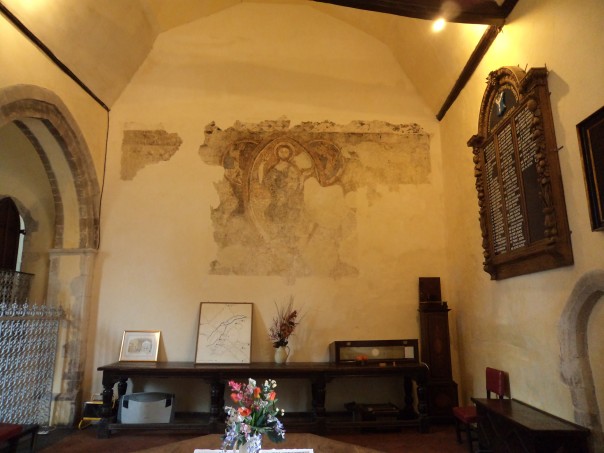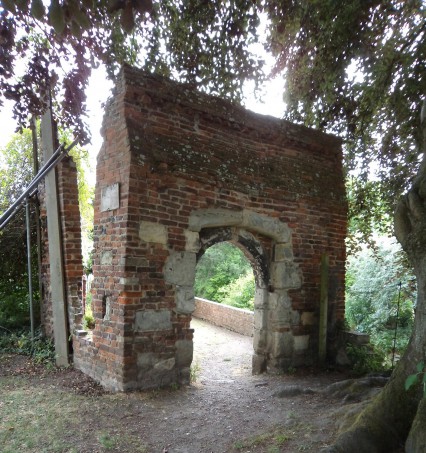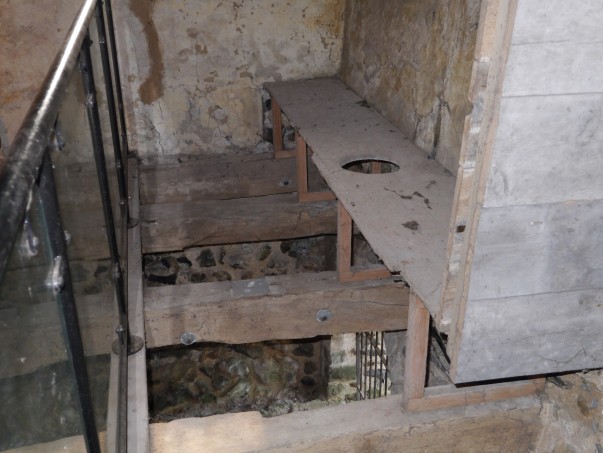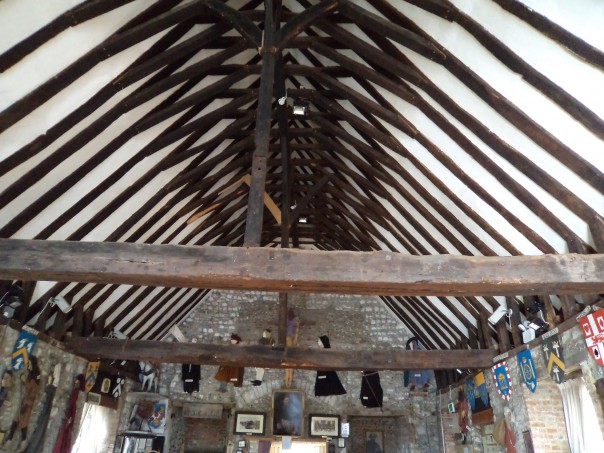This week celebrating Canterbury Festival’s walks that help Canterbury Archaeological Trust in its work to uncover the city’s past.

As some of you may know, it is that time of year again when during the Canterbury Festival a goodly number of people give up their time and freely give of their expertise to lead walks around Canterbury and to a lesser extent east Kent for the benefit of Canterbury Archaeological Trust. As usual Dr Doreen Rosman has done a splendid job of putting together a fascinating and varied programme (she took over from Meriel Connor who had done an equally excellent job over many years), and as last year I’m doing a couple: ‘Canterbury’s Medieval Friaries’ and ‘Canterbury’s Medieval Hospitals’.
Yesterday was the friaries and tomorrow the hospitals, and in-between I have been teaching but also starting to publicise the Medieval Canterbury Weekend 2020 on national and regional history and archaeology websites, including the Historical Association and Kent Archaeology Society. In case you missed the blog last week, the Weekend’s website is: https://www.canterbury.ac.uk/medieval-canterbury
However, for this week I thought I would just bring you a little about Canterbury’s Austin Friary, which only seems to have become known as ‘Whitefriars’ in Elizabeth I’s reign. Why I have no idea because that name really belongs to the Carmelites and there were such friars at Sandwich and Aylesford (still at the latter) in the Middle Ages. I’m picking on the Austin Friars because there are surviving friary buildings for the Dominicans (Black Friars) and Franciscans, later Observants (Grey Friars), but nothing survives above ground for the Austins and to be honest now probably only relatively little below ground following two lots of major rebuilding in the area since the Second World War. The shadowy Friars of the Sack were in Canterbury briefly but the only real reminder of them are the annual entries in the city’s late medieval chamberlains’ accounts of the letting out of the friars’ former premises.

Hence I’m going to stick to the Austin Friars. Firstly, they arrived very late on the Canterbury scene – almost a century after the Dominicans and Franciscans. After a short stay in the Westgate area, they moved in the early 1320s to Newingate ward (Rose Lane/St George’s Street area) when they were helped by Thomas of Bonnington and their leading aristocratic patron Hugh Despenser. As a serious rival in the local parish the Austin friars were not welcomed by the incumbent and his patron Christ Church Priory, the prior at Christ Church showing great reluctance when asked to give permission for the friars to move into a house there. Moreover, the prior may have expected any questions about the legitimacy of the friars’ arrival in St George’s would be decided in the church courts, and their next move presumably angered him still further. Apparently without waiting for the initial dispute to be resolved, the friars constructed an oratory where they celebrated divine service, an even greater infringement of parochial rights, especially as they had not sought archiepiscopal approval first. The archbishop convened an inquiry, but the commissioners did not proceed according to canon law, providing the friars with an opportunity to seek a compromise with their opponents. In 1326 an agreement was reached between Prior William Berneye of the Austin friars, and Christ Church Priory and the rector, Sir John of Nakington, whereby the priory and incumbent were to receive annually 13s 4d in compensation for the messuage (house and outbuildings) held by the friars, and a further 10s 8d each year for tithes (the rector receiving 9s, the priory 20d). This agreement strengthened the friars’ position, encouraging both the friars and their supporters to consolidate their presence in the parish; and using a vacant plot they had been given that abutted St George’s Street at the cloth market, they built their outer gatehouse, agreeing in 1356 to pay 2s 4d annually to Christ Church.

I think this is an important example because it shows how complicated the spiritual economy could be and similarly how it was vital for the friars to negotiate with others through ongoing systems of gift-giving and reciprocity, much of this relating to their ability to secure territorial space. Such negotiations were not solely with other religious houses because the friars were equally engaged in such exchanges with the civic authorities as a corporate body and with individuals. To demonstrate this, I just going to give a couple of examples for each.
Keeping with the friars’ new gatehouse on St George’s Street, initially this was not enough to allow them to construct a precincts wall until the early fifteenth century. Nevertheless, they were still acquiring land in the area during this period, and in order to gain seclusion for their community they needed to control two lanes that ran through their premises. As part of this process of consolidation, Prior John of Sturry leased from the city chamberlains at 4s per annum a crooked lane which ran from the north or outer gatehouse of the friary, next to the cemetery and church, towards another lane. Two years later, in 1431, and at a combined cost of 5s, the friars leased a second lane from the chamberlains which ran from opposite St Mary Bredin’s church via their postern (west) gate in the new stone wall towards the friary gardens in the east. To strengthen their claim to these lanes, and thus to their perimeter wall, the friars the same year petitioned the king and Henry VI granted the two lanes to them on the grounds that they ‘are lonely and little used but in which there is so much stench and filth that many infirmities daily befall those dwelling there’. The king also agreed that ‘by alms and great labour the friars have their house partially built but the building cannot be properly finished unless it is much larger’ and so in addition to the lanes he permitted them to receive a messuage and a garden for which they would pay 5s annually to the fee farm of the city. Nonetheless, the friars seem to have encountered some opposition to their actions, and the prior was summoned to appear before the king’s court to substantiate the friary’s rights to the area. He was successful, his attorney securing judgement in favour of the Austin friars in 1438. A few years later, they were apparently building again, and their second great gate may have replaced an earlier wooden structure.

Such points of contact between the friars and the civic authorities were important, it being understood that the friars should open their gates every morning and close them at night. Yet they were apparently prepared to defend their walled enclosure and to offer sanctuary to those who sought their protection. In 1525 the prior, William Mallom, and four friars drove off the coroner with sticks and knives when he tried to arrest for felony a woman who had sought sanctuary at the friary. However, on an earlier occasion (in 1499) they had been unable or unwilling to defend Alice the prostitute, who was fined 12d at the assize court for Newingate ward when she was convicted of having gone to the friary at night to meet certain friars, something she was said to have done on many occasions.
When it came to developing relationships with members of the laity, these too are instructive about the friars’ place in Canterbury society. For example, the expansion of the friary in the later 14th and early 15th centuries was presumably accompanied by a policy of creating a suitable range of buildings: Michael Denne bequeathed five thousand tiles to the friary church in 1394 and eleven years later Amelia Gobion left ten marks towards the new work there. All these activities may have led the friars to overstretch themselves because they were seeking royal assistance in 1408. In that year Henry VI allowed the friars to become landlords by giving them permission to rebuild houses and other buildings on their own land which was adjacent to St George’s Street.
Their imposing church and the friars’ activities in the neighbourhood presumably drew alms from local citizens and visitors to Canterbury, but the level of such giving is impossible to quantify. Consequently, any analysis of the support enjoyed by the Austin Friary in Canterbury must rest on the level and type of bequests recorded in wills. Of the eleven hundred known Canterbury testators between 1380 and 1538, 20% made at least one bequest to the Austin Friars, and of the 58 parishioners in St George’s parish making wills during the same period, 35% included the friary among their beneficiaries. Furthermore, comparing the level of testamentary support enjoyed by the friars and the monastic houses as a way of placing the Austin Friars among the city’s religious institutions, each of the three friaries received more bequests than any of the monasteries, albeit the Austin Friars were slightly less favoured compared to their Franciscan and Dominican brothers.

One of the spiritual gifts the friars could offer was as a place of burial. Yet the small size of the friary cemetery, it was squashed into a space between the church, the tenements abutting St George’s Street and the ‘crooked lane’, may have limited the number of people seeking burial there, but the friary church itself was chosen by at least twenty-eight local people. Indeed, the value of the friary as a family mausoleum was recognised by several married couples, including the Courtmans (1501, 1511); while William Catbury (1479) wanted to be near to his friend Christopher Hamer. Although some testators indicated their choice of burial site in terms of the church as a whole, such as in the south side, others selected specific altars or images and of these the image of Our Lady of Pity in the nave was especially favoured. Interestingly, only William Haute and his wives are known to have chosen burial before the image of St Katherine, his gift to the friars of a piece of her hair shirt a perpetual reminder of his devotion to this virgin martyr.
As well as offering provisions for the dead, the friars were concerned about relations with the living, and even though the evidence is limited, there may have been at least two fraternities at the friary, as well as being the church where the cobblers’ guild held their patronal services. Of the fraternities, the one dedicated to St Erasmus was presumably open to local laymen, like William Furnour (1524) of St Margaret’s parish, who gave two half-pound tapers to the fraternity. The second may have met in St Katherine’s hall at the friary. It seems to have had strong links with the neighbouring parish of St Andrew: in 1505 the churchwardens paid for the hall to be cleaned and for rushes for the floor. Moreover, the friars were prepared to store timber on behalf of the churchwardens when they were constructing substantial alterations to the St Andrew’s church rood loft, receiving gifts in return of a hundred herring, and 4s 10d worth of figs and raisins. These few examples would seem to suggest that generally the Austin Friars of Canterbury were reasonably successful, finding themselves a niche by negotiating their place with other sectors of the Church, the civic authorities and members of the laity. As a result, this Canterbury house seems to have prospered in the later Middle Ages compared to its difficult beginnings. However, the sixteenth century did bring different challenges, and like the other friaries in the city they were swept away in 1538, their house becoming a fine gentry residence which can be seen on the map dated c. 1640 in Canterbury Cathedral Archives.

Finally, I would like to thanks Chris Britcher, one of the feature writers at the Kent Messenger, for including a notice about the Medieval Canterbury Weekend at the end of his piece on the impact of the Black Death and subsequent outbreaks of plague in medieval and early modern Kent. We had a very interesting discussion on the phone about this topic last week and it’s great to see social history getting the recognition it deserves.
 Centre for Kent History and Heritage
Centre for Kent History and Heritage Sheila Sweetinburgh
Sheila Sweetinburgh 1599
1599

